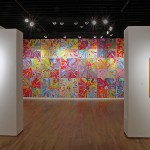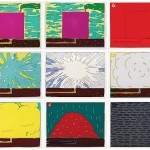Clear as a Bell: Peter Halley at Solway Gallery
By Keith Banner
Sometimes I walk in the dead mall near where I live when I want to clear my head. Tranquility emanates from all the shut-down luxury, the rubbed-off logos above vast empty storefronts, the black-garbage-bagged entrances surrounded in high-gloss marble and hard-wood. The colors on the walls and floors inside the place still throb with that Easter-egg vibrancy of mass-marketing, but all of that color and design is now a tribute to anonymous venture-capitalism slowly rotting into loneliness and amnesia. It’s a kind of sadness nobody really thinks about, a sort of mystical nostalgia rooted in things and places that never really mattered too much in the first place but now that they have no use or value a kind of poignancy arises.
The other night when I was walking around, all alone in that dead mall, I kept thinking about Peter Halley’s current show at Solway Gallery, a retrospective of his paintings and prints from the last 25 years. Halley is an abstract artist whose work has a rhetorical and even a philosophical bent toward representing an actual world just outside of the real one. It’s a paradox, each of his beautifully made pieces both ironic and almost sentimental at the same time as he searches through architectural drawings and organizational flow charts for subject matter that seems banal at first but then through a sort of Day-Glo alchemy Halley finds a menacing, Stanley-Kubrick-tinged glamour, a way to make meaninglessness feel both absolute and emotional. And also like Kubrick, Halley is obsessed with figuring out how “organizational structures” work themselves out through a maze of secrets and stunned silences.
A lux practicum of imaginary cells and prisons, Halley’s prints and paintings have a luminous rigidness that seems both playful and sinister, a minimalist architect’s daydream somehow freezing into a Pop-Art nightmare overnight. Case in point, the beautiful installation consisting of “Borderline,” a Dal-Glo acrylic painting from 2012, hung on “Static Wallpaper,” screen-printed wallpaper that hums while the painting sets you straight in loud, triumphant syncopation. “Borderline” gives off that anonymous, dead-mall feel, as do Halley’s prints, a sort of enigmatic nothingness that is both referential and indeterminate. The poetry here is interstitial, wordless paragraphs pulsating from Halley’s restricted visual vocabulary.
A board-game insouciance materializes in “Three Prisons,” a screen-print on paper from 2002 that has a sort of mod-60s giddiness merged with the finality and grimness of an art-deco Panopticon. He’s representing prison floor-plans here, but that stark choice is counterbalanced by his need for color-blocking, especially that ridiculous orange in the prison in the middle. Halley seems to be locating logos here for future totalitarian states, fetishizing the need for order into stained-glass windows from distant planets.
That poststructuralist bent glides through almost every piece of art Halley makes. His choice of subject matter, and the media and artifice he chooses to relay it with, combat one another in an anodyne but unnerving battle for obscurity and plainness. It’s like propaganda for a Utopian society living on the edge of madness, but always finding a way to work everything out. “Exploding Cell” from 2013, a glossy electric-blue acrylic wall-relief, is dazzlingly static. In Halley’s universe, even the explosions are frozen, trapped in beautiful polystyrene prisons, somehow acquiring the colors and frost of 1980s fingernail polish.
One of Halley’s best appropriated tropes comes from bureaucratic flow-charts. In “Final Attributes, Organizational Charts,” a silkscreen on frosted Mylar from 1990, he somehow reifies what’s real, a redundancy that provides an aesthetic coloring-book, sort of like Mondrian daydreaming of IBM. Halley wants reality to be one step closer to dream but he doesn’t want to mess with Surrealism, just the absurdity of what’s right in front of you, clear as a bell.
Michael Foucault, in Discipline and Punish, referencing Jeremy Bentham’s Panopticon, that all-seeing institutional eye, writes, “If the inmates are convicts, there is no danger of a plot, an attempt at collective escape, the planning of new crimes for the future, bad reciprocal influences; if they are patients, there is no danger of contagion; if they are madmen there is no risk of their committing violence upon one another; if they are schoolchildren, there is no copying, no noise, no chatter, no waste of time; if they are workers, there are no disorders, no theft, no coalitions, none of those distractions that slow down the rate of work, make it less perfect or cause accidents.”
Halley reimagines robotic conformity in his works, finding a way to brighten the corners while also paying attention to the blank walls. The antiseptic clarity and the sense of the absurd create quiet moments of horror that you can ignore but not escape. Foucault locates that same sense of entrapment in Discipline and Punish by focusing his attention on the way buildings and societies are constructed around the idea of surveillance taking over our lives without so much as a peep out of anybody. Convicts, patients, schoolchildren, inmates – we’re all the same at the end of the day. Walking in a prison is the same thing as walking in a mall.
The mall I walk in, as I said before, is dead – just a couple of stores left, like post-apocalyptic attempts at normalcy. Otherwise, there’s complete vacancy where currency used to be. It’s the same colors, the same lines from yesterday – that architecture and interior decoration of happy times and spending money spliced with the need to maintain order, to ensure nobody shoplifts or sets fires or worse. That fusion of security and luxury, when it is uninhabited, is a dream of quarantine. Ghostliness descends like fine dust, and the haunting happens in a vacuum of forgotten connections. At the front entrance of the deal mall is a huge map of what the mall was like in its heyday. It’s a Plexiglas masterpiece backlit with fluorescence, and each quadrant of the mall-map has its own Day-Glo color code, referencing where to go for men’s and women’s clothing, toys, stationary, food, housewares, etcetera.
I swear to God Peter Halley made it.
- Peter-Halley-Explosion Panic-Room Deep-End Photo courtesy of Solway Gallery.
- Peter-Halley – Borderline_Static-Wallpaper2 Photo courtesy of Solway Gallery.
- Halley-Exploding-Cell-color-fullset-1994 Photo courtesy of Solway Gallery.
- Cell-with-Smokestack-V-1999 Photo courtesy of Solway Gallery.








